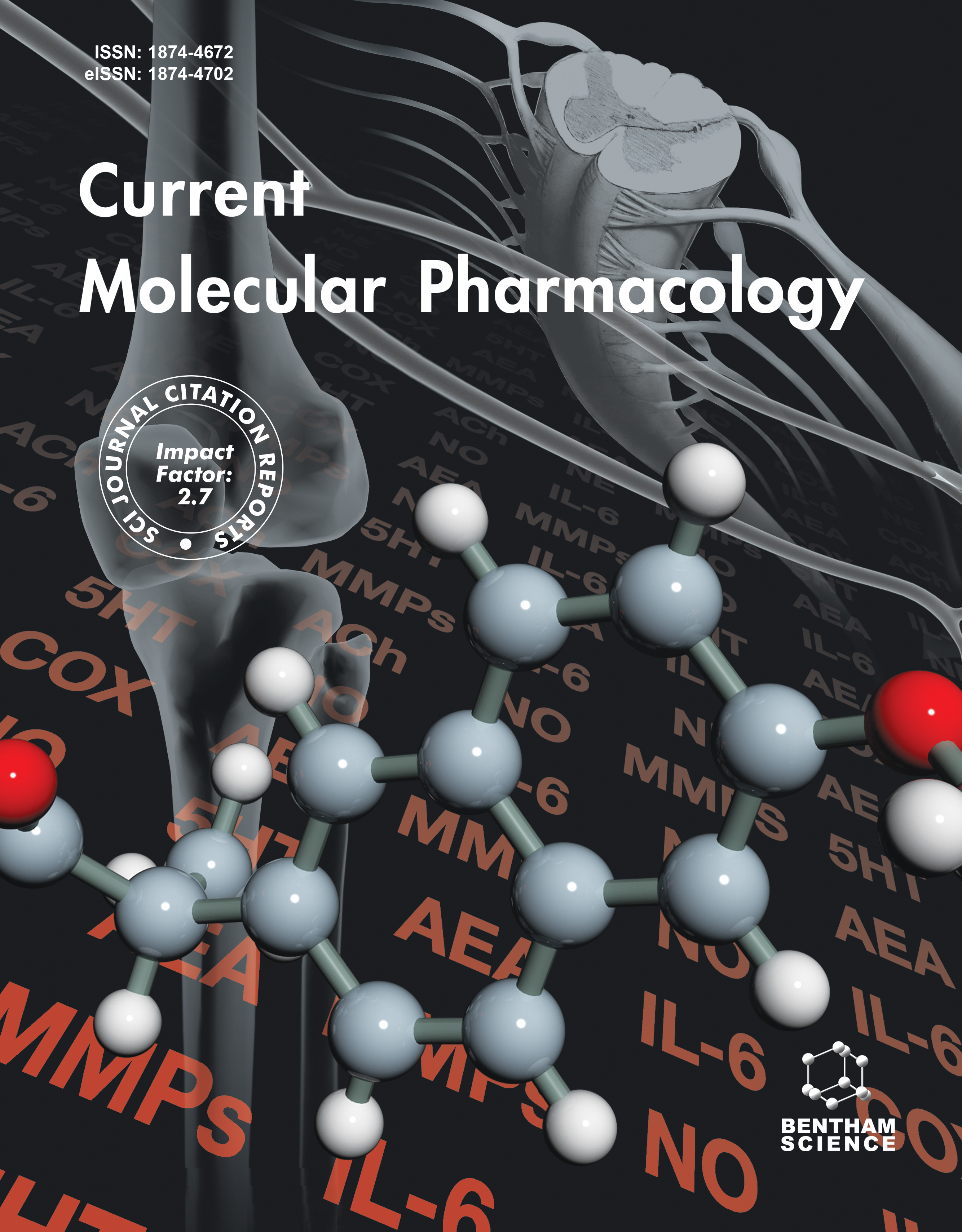- Home
- A-Z Publications
- Current Molecular Pharmacology
- Previous Issues
- Volume 12, Issue 4, 2019
Current Molecular Pharmacology - Volume 12, Issue 4, 2019
Volume 12, Issue 4, 2019
-
-
In-vitro Pre-Treatment of Cancer Cells with TGF-β1: A Novel Approach of Tail Vein Lung Cancer Metastasis Mouse Model for Anti-Metastatic Studies
More LessBackground: Aggressive behavior of tumor metastasis comes from certain mutations, changes in cellular metabolic and signaling pathways that are majorly altered by tumor microenvironment (TME), its other components and growth factors like transforming growth factor-β1 (TGF-β1) which is chiefly known for its epithelial to mesenchymal transformation (EMT). EMT is a critical step of metastasis cascade in actual human lun Read More
-
-
-
Bafilomycin-A1 and ML9 Exert Different Lysosomal Actions to Induce Cell Death
More LessAuthors: Soni Shaikh, Suman K Nandy, Carles Cantí and Sergio LavanderoObjective: Bafilomycin-A1 and ML9 are lysosomotropic agents, irrespective of cell types. However, the mechanisms of lysosome targeting either bafilomycin-A1 or ML9 are unclear. Methods: The present research has been carried out by different molecular and biochemical analyses like western blot, confocal imaging and FACS studies, as well as molecular docking. Results: Our data shows that pre-incubation of neonatal Read More
-
-
-
Mesalazine Activates Adenosine Monophosphate-activated Protein Kinase: Implication in the Anti-inflammatory Activity of this Anti-colitic Drug
More LessAuthors: Heejung Park, Wooseong Kim, Dayoon Kim, Seongkeun Jeong and Yunjin JungObjective: Mesalazine, 5-aminosalicylic acid (5-ASA), is an anti-inflammatory drug that is most widely used for the treatment of Inflammatory Bowel Disease (IBD). Despite extensive clinical use, the exact pharmacological mechanism underlying the anti-colitic effects of 5-ASA has not yet been elucidated. A potential molecular mechanism underlying 5-ASA-mediated anti-colitic activity was investigated. Methods: An anti-inflamm Read More
-
-
-
Synergistic Effect of Epigenetic Inhibitors Decitabine and Suberoylanilide Hydroxamic Acid on Colorectal Cancer In vitro
More LessAuthors: Sonia A. Najem, Ghada Khawaja, Mohammad Hassan Hodroj and Sandra RizkBackground: Colorectal Cancer (CRC) is a common cause of oncological deaths worldwide. Alterations of the epigenetic landscape constitute a well-documented hallmark of CRC phenotype. The accumulation of aberrant DNA methylation and histone acetylation plays a major role in altering gene activity and driving tumor onset, progression and metastasis. Objective: In this study, we evaluated the effect of Suberoylanilide Hydrox Read More
-
-
-
The Psychiatric Drug Lithium Increases DNA Damage and Decreases Cell Survival in MCF-7 and MDA-MB-231 Breast Cancer Cell Lines Expos ed to Ionizing Radiation
More LessAuthors: Maryam Rouhani, Samira Ramshini and Maryam OmidiBackground: Breast cancer is the most common cancer among women. Radiation therapy is used for treating almost every stage of breast cancer. A strategy to reduce irradiation side effects and to decrease the recurrence of cancer is concurrent use of radiation and radiosensitizers. We studied the effect of the antimanic drug lithium on radiosensitivity of estrogen-receptor (ER)-positive MCF-7 and ER-negative, invasive, a Read More
-
-
-
Effects of Myo-inositol Alone and in Combination with Seleno-L-Methionine on Cadmium-Induced Testicular Damage in Mice
More LessBackground: Cadmium (Cd) impairs gametogenesis and damages the blood-testis barrier. Objective: As the primary mechanism of Cd-induced damage is oxidative stress, the effects of two natural antioxidants, myo-inositol (MI) and seleno-L-methionine (Se), were evaluated in mice testes. Methods: Eighty-four male C57 BL/6J mice were divided into twelve groups: 0.9% NaCl (vehicle; 1 ml/kg/day i.p.); Se (0.2 mg/kg/day per Read More
-
-
-
H19/miR-675-5p Targeting SFN Enhances the Invasion and Metastasis of Nasalpharyngeal Cancer Cells
More LessAuthors: Ting Zhang, Fanghong Lei, Tao Jiang, Lisha Xie, Pin Huang, Pei Li, Yun Huang, Xia Tang, Jie Gong, Yunpeng Lin, Ailan Cheng and Weiguo HuangAims: The aim is to study the role of miR-675-5p coded by long non-coding RNA H19 in the development of Nasopharyngeal Cancer (NPC) and whether miR-675-5p regulates the invasion and metastasis of NPC through targeting SFN (14-3-3σ). The study further validated the relationship between H19, miR-675-5p and SFN in NPC and their relationship with the invasion and metastasis of NPC. Methods: Western blot was use Read More
-
Most Read This Month
Article
content/journals/cmp
Journal
10
5
false
en


